luciana achugar premieres An Epilogue for OTRO TEATRO: True Love.
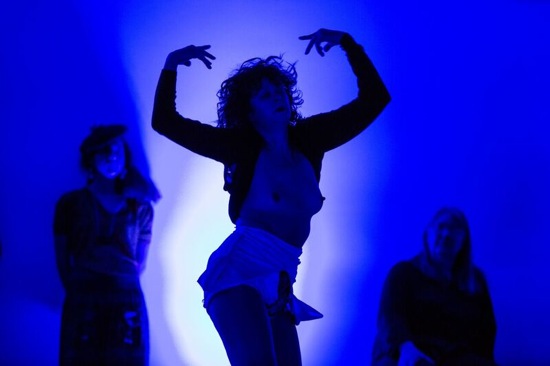
(L to R): Rebecca Wender, Jennifer Kjos, and luciana achugar in achugar’s An Epilogue for OTRO TEATRO: True Love. Photo: Scott Shaw
It’s November, 2006, and I’m sitting on one of the highest carpeted risers in St. Mark’s Church watching Luciana Achugar’s Exhausting Love. Suddenly one of the performers (Hilary Clark) works her way toward me and my companion and wedges herself between us. Other cast members are also bridging the audience-performer divide. Most spectators stare straight ahead; that’s where the performance is supposed to take place, right? Hmm. . . .
It’s April, 2014, and I’m entering New York Live Arts’ black box theater to see Achugar’s Otro Teatro. The line moves slowly. That’s because an almost completely shrouded figure is kneeling in the doorway, kissing the left foot of each entering patron. It is the choreographer.
It’s December, 2015, and—perhaps because, a) I’m late arriving for Achugar’s An Epilogue for OTRO TEATRO: True Love, b) I’m a critic, and c) I’m almost the only person in the Gibney Dance: Agnes Varis Performing Arts Center with gray hair—I’m given a chair. Almost all the other spectators sit on the floor, leaning against the studio walls or forming clusters to be stepped into or surrounded by the performers.
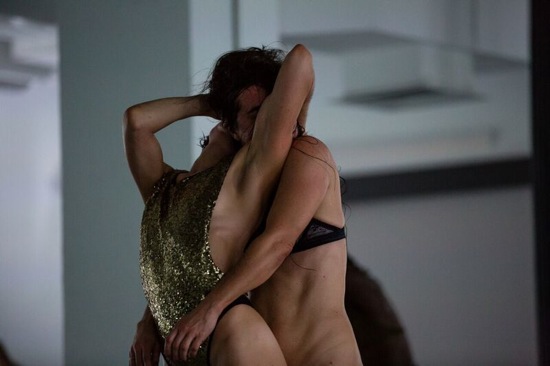
Molly Lieber and luciana achugar in achugar’s An Epilogue for OTRO TEATRO: True Love. Photo: Scott Shaw
The adventurous, thoughtful Uruguay-born choreographer (who now lower-cases the initial letters of her name) has been pursuing two related missions during the two decades. One, obviously, is to query and subvert the “third wall” of traditional theater in order to induce kinesthesia in the audience. She wants, I think, to make our own bodies respond viscerally to what she is showing us. In a short talk she delivered during her 2008 The Sublime in Us, she urged us like a well-intentioned therapist (I’m paraphrasing here) to turn off our brains (meaning their intellectual, objective function) and think with the brains in our butts. (I’m glad she moved past that approach.)
achugar is concerned with the body in ways that most dancers ignore or repress. Her mission statement for Otro Teatro and its “epilogue” says, in part “To give our body their voice back, with a practice of pleasure; to practice growing a body as one would grow a plant; a utopian body; a sensational body; a connected body. . .with a brain that melted down to the flesh, the blood, the bones. . . .” That meltdown, that return to a kind of primality, is what she hopes we will not only see, but experience.
Some of achugar’s previous works have been darkly mysterious—witchy even, and elements in An Epilogue hint at that territory, as do the subtitles of its four parts:“True Love,” “Praying,” “Unraveling,” and “Spellcasting.” However the darkness in this piece evokes not only primal rituals, but the nightclub darkness that hides secrets yet is often suffused with vividly colored and patterned lights (lighting designer: Madeline Best). That one wall is mirrored amplifies the effects.
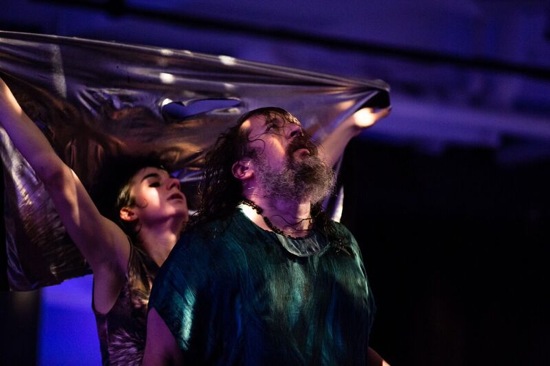
Molly Lieber and Michael Mahalchicjk in luciana Achugar’s new work. Photo: Scott Shaw
The music also evokes a club atmosphere. Expert sound engineer Peter Jacobs (surrounded by more cartons of LPs than he could possible play in one performance) mans a series of turntables. Slipping records in and out of their sleeves, segueing a tune on one disk into a track on another, overlapping them, messing with them, he keeps the disco beat throbbing through a wealth of transformations.
Most of the time, the eight dancers work at pulling that beat out of their inner card catalogue of movements. Focus on any one of them (achugar, Oven Barnoy, Shantelle Jackson, Nikima Jagudajev, Jennifer Kjos, Molly Lieber, Michael Mahalchick, or Rebecca Wender), and, if they’re on their feet, you’ll almost always see that person doing the familiar step-stamp that often marks time on a dance floor; the knees pulse, and the stamping foot rebounds, so that the feeling, although grounded, has a lift to it. The dancers’ hips may sway, their upper bodies swing and shrug; there’s no end to what those unstopping feet can power.
They’ve risen from among the spectators or been prowling around the room before the doors are closed. In the beginning, dimly lit, they work in a cluster, stepping to the beat, turning. (I think briefly of protons and electrons swimming in a nucleus); they assume a common direction and travel toward it. At some point, they hang onto each other, bending over as they go. Eventually the clump spreads out and a task in which they copy one another develops. All this time, upward-aimed lamps on the floor turn the walls purple.
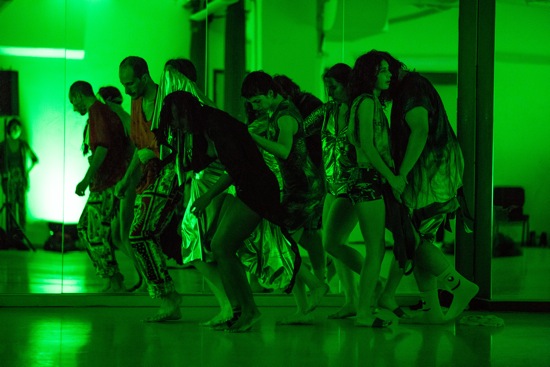
(L to R): Oren Barnoy, luciana achugar (masked), Shantelle Jackson, Molly Lieber, Rebecca Wender, Nikima Jagudajev, and Michael Mahalchick. Photo: Scott Shaw
As An Epilogue progresses, you can note themes and movements that echo or build upon ones in Otro Teatro and other achugar works. One is shiny fabric. Gleaming silver and gold garments are removed and tossed aside or transferred to others while all are still dancing. Occasionally, one of the shirts is pulled up by its wearer to cover his/her face. For a long time, achugar’s hip motions cause her tights to slide down; eventually she pulls herself free of them. As in The Sublime is Us, a dancer (both Wender and achugar the night I attended) dances nose-to-nose with her mirror image. In another retrospective move (achugar performed it countless times in her 2006 Exhausting Love), a dancer gets down on all fours (forearms and knees, hands and feet, etc) and undulates her spine in unmistakably sexual ways—sometimes traveling as she goes (if she is naked, you see her buttocks opening and closing rhythmically).
Inevitably, over the two-plus hours, the dancers visibly tire; they’re slick with sweat, burned down. The lights goad them—turning green or red or dancing via mirror balls that throw discs of light on the walls. Jacobs’s music is unrelenting. As the dancers pick their way through the crowd, they seem to want to engage more spectators. They surround one man sitting on the floor and doing his own sympathetic dance; you can see his feet flipping in time with the music as they crowd in, then move on. Two audience members (dancers), then a third are moved to get up and join the cast, but they haven’t practiced the stamina needed for what comes to resemble a Depression-era dance marathon, and they bow out after a while. At one moment, I thought that achugar could barely continue to lift her feet, but she kept going.
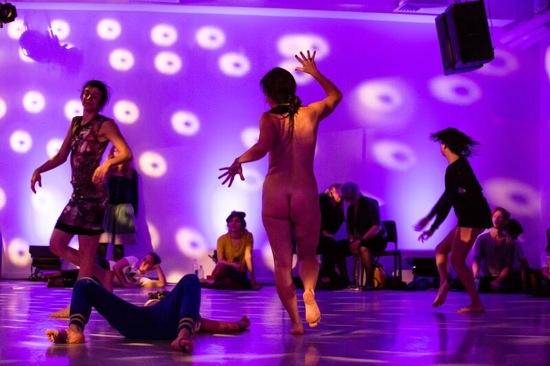
luciana achugar’s An Epilogue for OTRO TEATRO: True Love. (L to R): Molly Lieber, Nikima Jagudajev (supine), luciana achugar, and Jennifer Kjos. Photo: Scott Shaw
The performers engage with one another more often late in the piece. Jackson comes down from a box she’s been standing and supports Lieber, who is arching perilously far backward. In the evening’s bit of surprise virtuosity, Lieber, rolling on the floor with Kjos, adroitly hooks with her feet a black tutu that Wender has tossed aside earlier and back-somersaults with the mess of black net riding high. And sometimes, they ignore the music-driven foot action or minimize it. For quite a while, Jagudajev stands amid some spectators making large, smooth, winging gestures with her arms.
On and on the valiant performers go. A few spectators leave fairly early; others trickle out. (Are they tired? Bored? Offended? Do they have a late date?) Many of those remaining recline, prop themselves up on an elbow, lean on a friend, slide down the wall a little. I realize only later, that I haven’t parsed the evening into its four sections. Are we in “Spellcasting” at around the two-hour mark? I sense a change, perhaps an ending, when many of the dancers have made it into the center of the space and are, most of them, lying down.
Suddenly, I am very tired. Is this a sign that kinesthesia has been achieved—at least a little bit? Maybe. I unaccountably do what I’ve done only once in my life. I look at my husband and say, “shall we go?” And we slip out the back door.
I’m hoping that someone who stayed the course will (please?) post a comment or shoot me an e-mail telling me how An Epilogue for OTRO TEATRO: True Love ended— on this night or any other. I’d like to know. This review needs its own epilogue.
